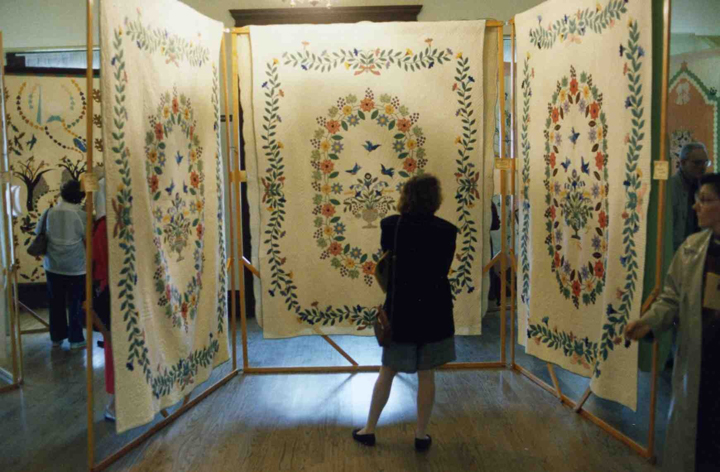BACK TO ESSAYS
Mary Gasperik (1888-1969): Her Life and Her Quilts
"I came to America on January 6, 1905, and arrived in Chicago to my sister, Annuska...".
The journey from Hungary set in motion a transformation—from Mariska Mihalovits, a teen-aged immigrant arriving in the bustling city of Chicago in 1905, to Mary Gasperik, a middle-aged woman in 1936, beaming with pride as she stands with her fellow club members in front of her prizewinning quilt. Clearly, quilts played a major role in Mary Gasperik's journey to find her place in American society.
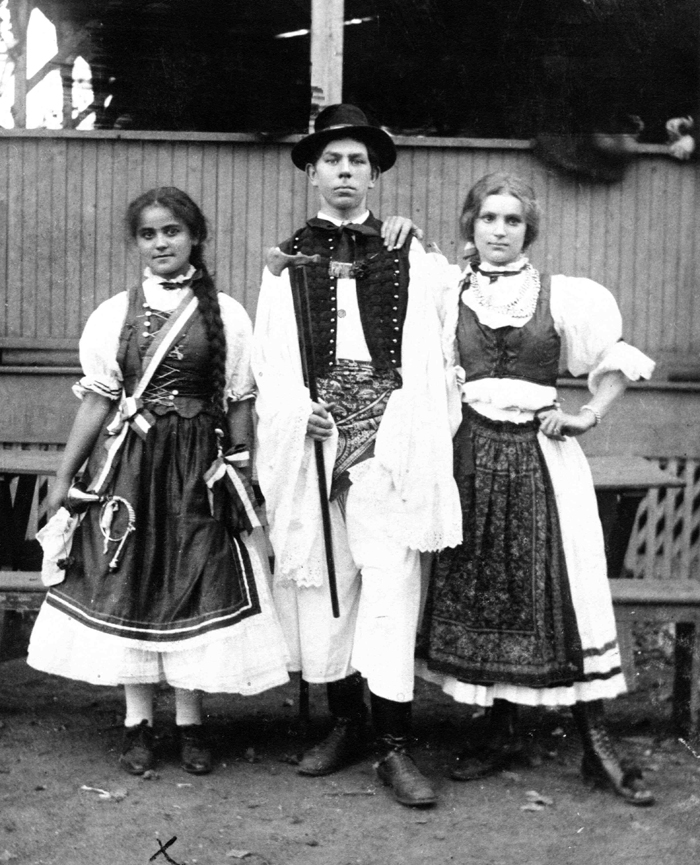
Mariska (left) and Elizabeth (right) Mihalovits, 1905.
Mariska Mihalovits arrived in Chicago from Hungary at the age of 16 in January 1905. While earning a living as a household servant, she met and married fellow Hungarian Stephen Gasperik. They moved to Burnside, a Hungarian immigrant community on the South Side of Chicago, where Stephen later bought and managed a grocery store and ran a milk delivery business. Mary and Stephen raised three children in the living quarters behind the market—Stephen, Elsie and Elmer.
With her children grown, Mary discovered quilts at the age of 45, when she saw the Sears Contest quilts displayed at the 1933 Chicago World's Fair Century of Progress Exposition. Soon after, she joined a quilting club at a neighborhood park (Tuley Park Quilting Club) where she received instruction, advice, ready access to the latest patterns, and an opportunity to display her handiwork at club exhibitions.
That first year, she made six quilts—all carrying an embroidered reference to the 1933 Century of Progress contest. Competing for prizes and displaying her quilts in public motivated her to work quickly. Over the next 33 years, she won many prizes and ribbons at exhibits sponsored by The Detroit News and at state fairs in Illinois and Indiana. Her appliqué and quilting caught the attention of the judges. However, when she entered an originally designed quilt Road to Recovery in the 1939 New York World's Fair contest, it was returned without a ribbon. Today, it is one of her most enchanting quilts.
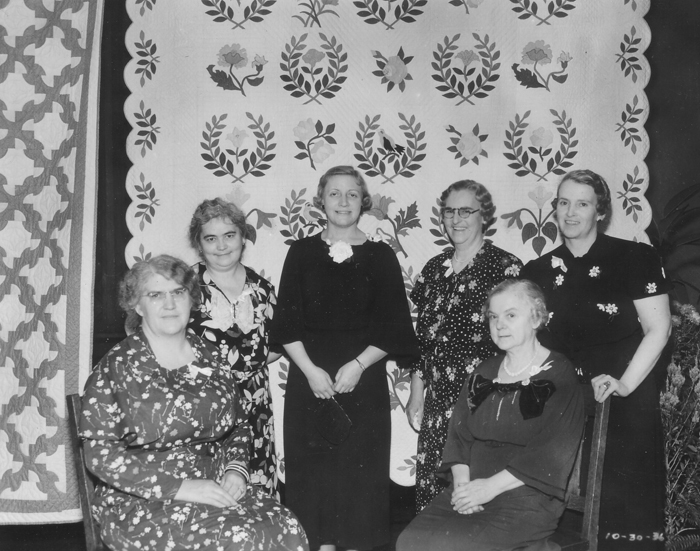
Mary Gasperik (second from left) with the Tuley Park Quilt Club. They are posing before Gasperik's Laurel Leaf quilt.
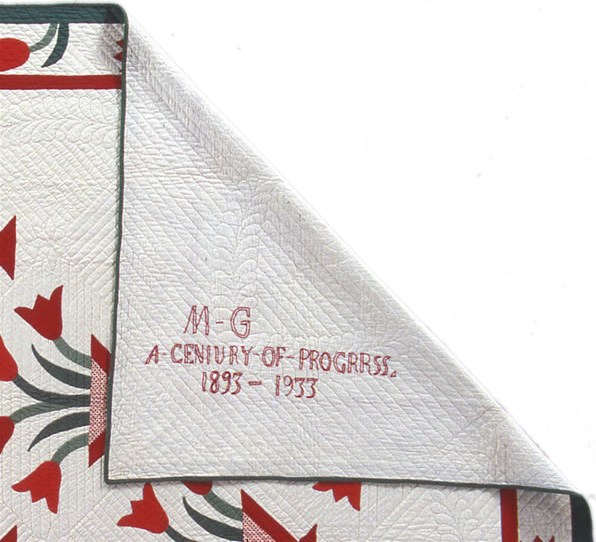
This label is on the back of Gasperik's Tulip Basket quilt.
She also enjoyed making quilts for her children and grandchildren, often using the same design, but making some adjustments for each child's quilt. Fortunately most of the Gasperik quilts are still held within the family circle. Her only daughter, Elsie, supported and encouraged her mother's quiltmaking interests as she grew older. Mary died in 1969. Elsie died in 1988. Before Elsie died, she distributed her mother's portion of quilts among the three adult siblings. In 1991, Elsie's three daughters Karen, Linda, and Susan divided up the quilts that belonged to their mother. Soon after, they decided to try to organize an exhibit of Mary's quilts in California where Karen and Susan lived.

Mary Gasperik with daughter, Elsie Krueger, and granddaughters, Karen and Linda.
In 1992, the grandchildren, by then dispersed throughout the United States and raising children of their own, reconnected to display their quilts at the Ravenswood Historic Site in Livermore, CA. They had the quilts professionally photographed and prepared a catalog with the information they remembered about the quilts. Those who did not travel to the show received catalogs and albums of the quilt photographs. The family's appreciation for their grandmother and her quilts grew. Susan Salser embarked on a personal quest to research her grandmother and her quilts. Her findings are now being shared with a much larger audience via the internet.
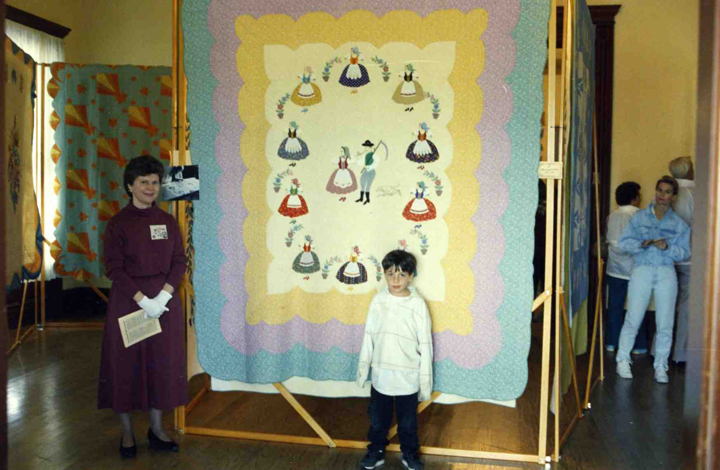
Great-grandson, Dylan Gasperik, with Hungarian Harvest Festival quilt at 1992 Livermore, CA exhibit.
This online collection of The Mary Gasperik Quilts marks the first private collection of quilts to be incorporated into the Quilt Index. Granddaughter Susan Salser and other family members conducted meticulous and ongoing research into family accounts and published sources. This passionate research effort has resulted in a rich set of stories and details about the quiltmaker's life and family as well as nearly unparalleled depth and accuracy about the quilt and quilting patterns.
What Sets This Collection Apart?
What sets Mary Gasperik apart from other quilters and makes her worthy of study are her expert needlework skills in appliqué, embroidery and quilting. Her quilts balance overall form and innovation with intricate and detailed handiwork. These quilts are gems to examine up close as well as from across the room.
Moreover, hers is an immigrant's story. Through the lens of her quilts, we gain a glimpse of her personal acculturation. Though she may have been isolated with limited English language skills, Mary Gasperik took something purely American and made it her own. We see how her American quilts are often embellished with Hungarian flowers, emblems and flags.
What makes her quilts valuable to quilt historians is that the 80 quilts were made by one person, in one community, during a specific time period. The fact that her hometown was Chicago, site of the important and influential 1933 Chicago World's Fair Sears National Quilt Contest and home to many companies that published the quilt catalogs and needlework patterns which fueled America's resurgent interest in quilts, makes her quilt epiphany at the Fair and ensuing career all the more significant.
She incorporated and experimented with just about every quilt design source available to her. We can approximate the dates of her quilts by examining the sources of her patterns and searching for those patterns or kits in dated advertisements, newspapers, or copyright booklets. Susan remembers the tall stacks of quilt- and needlework-related popular magazines and catalogs in the dining room, which was her quilt work-room. Mary paid close attention to the latest in quilt ideas and fashions, providing further clues to help decipher the order in which she made her quilts.
This story proves how important those "boxes under the bed" are. Quiltmakers often leave a paper trail to follow. In Mary Gasperik's case, her box included correspondence with Edith Crumb of The Detroit News, photos of her quilts on display at Tuley Park, prize ribbons and quilt caption cards, stencils, hand-drawn appliqué and quilting designs, and much more.
How Waldvogel and Salser Met: Research Roads Merged
In 1992 when Barbara Brackman and I were collecting background stories and quilts for our book Patchwork Souvenirs of the 1933 Chicago World's Fair (Rutledge Hill Press, 1993), we chose Susan Salser's Star Arcturus – Century of Progress by her grandmother Mary Gasperik. Although the quilt was not made for the contest, the pattern was a published pattern that commemorated the 1933 Chicago World's Fair. When we learned that Gasperik's quiltmaking career began when she saw the contest quilts, we decided to add a chapter on the aftermath of the contest. Her quilt toured with the other quilts featured in the book to eleven museums throughout the United States.
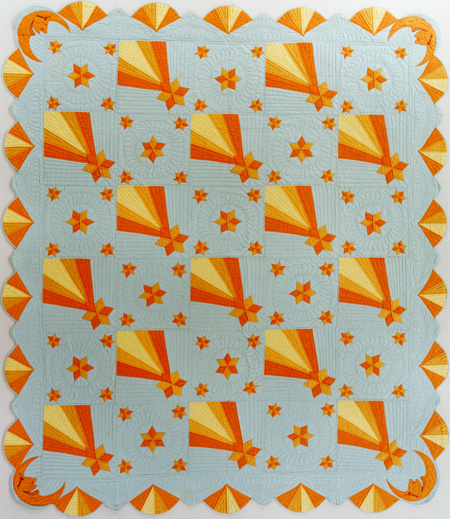
Star Arcturus
Mary Gasperik
Chicago, Illinois
1934
Private Collection
This quilt probably made early in her career in 1934, incorporates a Nancy Cabot (Chicago Tribune) pattern that honors the 1933 Century of Progress Exposition.
Salser purchased this block her grandmother made on eBay.
Susan Salser decided to research all her grandmother's quilts. Her sisters supported her efforts. Over the next years, she traveled to Hungary to see her grandmother's homeland and meet her relatives. While there, she learned of another Indians quilt her grandmother had sent to a relative in Hungary. She later corresponded with the owner (one of the four brothers to whom it was given after the war), who sent several photographs of this much worn quilt. She located a Gasperik Wedding quilt at the Los Angeles County Museum of Art that her grandmother had given to a niece who later donated it to the museum. Susan began corresponding with this niece, who, in addition to sharing memories, gave Susan old family photos which had belonged to Bruland's mother -- Mary Gasperik's oldest sister Anna (Annuska), who had sponsored her emigration.
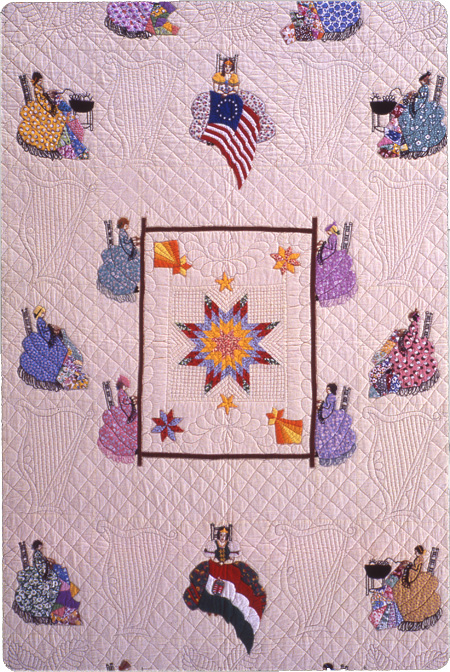
Center detail of Gasperik's Colonial Quilting Bee includes Star Arcturus and American and Hungarian flags.
I helped her identify Mary Gasperik's quilt designs using commercial kits and published patterns I own. Together we also searched state quilt books and online quilt auction sites for examples of quilts made in kits and patterns that Gasperik used. On ebay, she found and later purchased a sample block of Star Arcturus, which her grandmother sent to a fellow member of The Detroit News Quilt Club Corner in Michigan some 70 years earlier!
Together we unraveled the story of how Mary Gasperik connected with The Detroit News Quilt Club. According to a October 22, 1935 News quilt column, she was attending a 1935 World Series game between the Detroit Tigers and the Chicago Cubs in Chicago and picked a copy of The Detroit News left by a fan of the opposing team. Inside the newspaper, she saw a notice of the upcoming 1935 quilt exhibit in Detroit. Within weeks she sent quilts and took the bus to see the quilt show.
Through her local Santa Monica Public Library, Salser ordered microfilm rolls of The Detroit News from the 1930s and 40s. They arrived via interlibrary loan at her local library. To the delight of both of us, she located the baseball story in three places—in October 1935 when Mary surprised Edith Crumb, director of The Detroit Quilt Club, by coming in person, having sent one quilt top which arrived too late to be hung (February 11, 1936) and twice later (February 11, 1936 and October 9, 1938) when reporters described how this Chicago quiltmaker who won so many prizes first learned of The Detroit News quilt show.
By reading the quilt columns, Salser learned that her grandmother attended all the Detroit shows from the time she first discovered them: 1935, 1937, 1938 and 1940. Wondering why Gasperik didn't enter the 1936 show, Salser learned from the microfilm that it was not held and that Mary had written a club member asking about the 1936 show because she was ready to send five new quilts! Not only was she proficient and enthusiastic, she was also motivated by the chance to display her quilts and compete for prizes.
Coincidentally, I received a collection of Detroit News clippings from the 1930s. I was surprised to find a photograph and story of a quilt by Marjorie Miller ("Mrs. Arthur Miller") of Detroit that is similar in layout and appliqué designs to Mary's masterpiece quilt, Colonial Quilting Bee. I had assumed that Gasperik's quilt was an original design. Miller's quilt, photographed by The Detroit News in January 1936 featured two dozen quiltmakers with quilts on their laps sitting around a miniature crazy quilt on a frame. According to the newspaper story, the appliqué pattern for the quilting ladies were available as Lady Making Patch Quilt Silhouette through the newspaper.
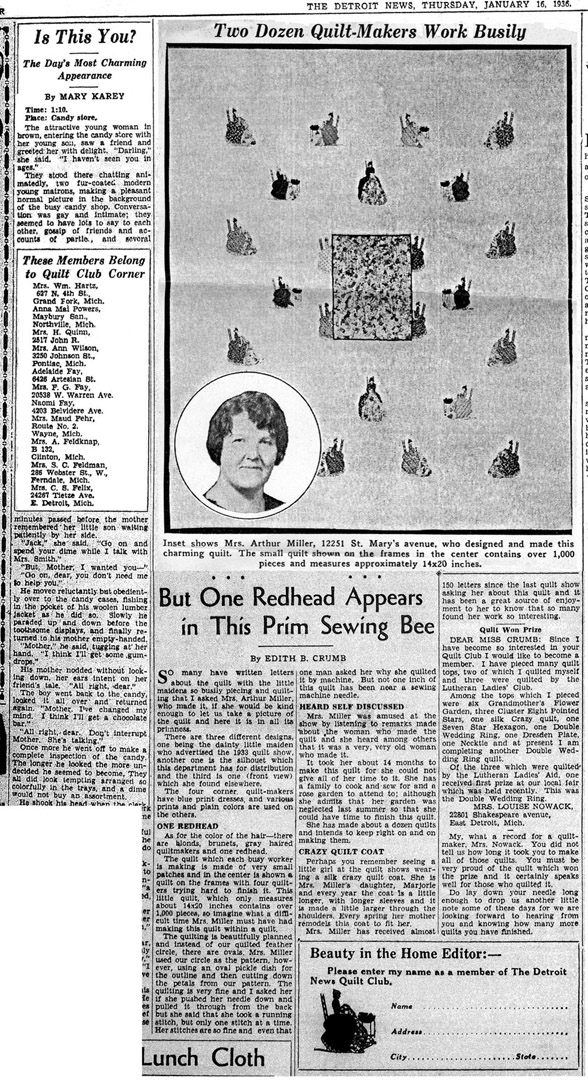
Detroit News January 16, 1936, "Mrs. Miller" and her Quilting Bee quilt.
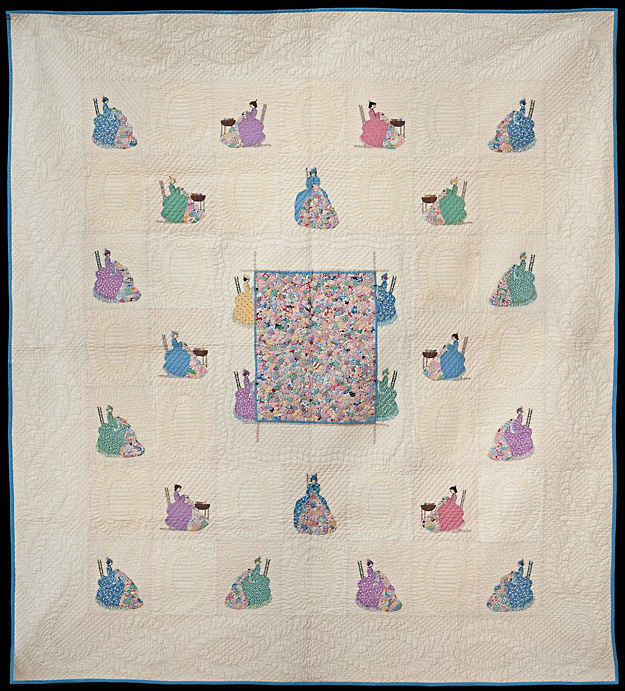
Colonial Sewing Bee
Marjorie Miller
Detroit, Michigan
1935
Private Collection
The Miller quilt mentioned in the Detroit News article was documented with the Michigan Quilt Project in 2013.
"Our little patchwork lady" as Edith called her, was the official symbol of the Detroit Quilt Show. This encouraged club members to make quilts with that logo. Mary Gasperik must have seen Miller's quilt and decided to make one herself. To personalize hers, she incorporated Hungarian and American flags and placed a miniature Star Arcturus quilt on the center quilt frame. After all, her career began with that quilt.
Another fortuitous discovery in the same collection was a sketch of Mary Gasperik's Double Feather Star on display at a 1937 Detroit News exhibit. The sketch was one of several hundred drawn by an Indiana quilt authority, Frances Purcell, for her quilt pattern library. She must have visited the exhibit in Detroit, sketched the quilt, noted the colors of the quilt and copied the caption card that noted the source of the pattern in a book by Marie Webster and Mary Gasperik as the quiltmaker. Purcell's annotated sketch helped Salser determine which of the three surviving Gasperik Double Feather Star quilts won a 1937 prize.
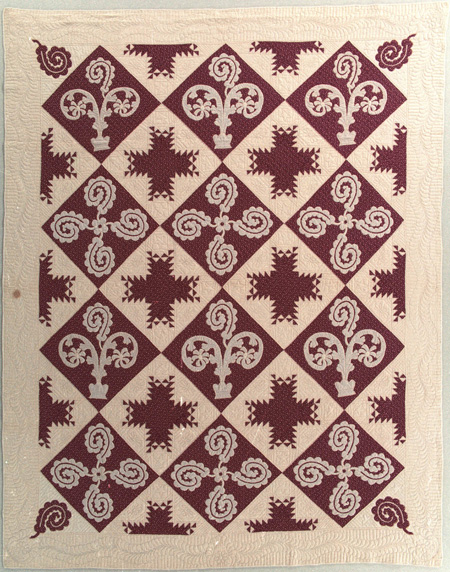
Double Feather Star
Mary Gasperik
Chicago, Illinois
1937
Private Collection
This quilt was one of four quilts Gasperik entered in the April 1937 Detroit News Quilt Show and Contest. She won four Detroit Honorable Mention ribbons that year. Mary Gasperik made at least three versions of the quilt she called Double Feather Star, whose pattern she made from a photograph (of a small portion of an antique quilt called "Feather Star with Appliqué") in Marie Webster's book. Mary altered the antique quilt design; and the three surviving quilts differ from each other in pattern arrangement (as well as quilting). To a casual observer, the quilts look alike, but closer inspection reveals differences.
Obviously, luck and perseverance played a role in our combined efforts to authenticate all the design sources – commercial and folk – that this prolific quiltmaker used.
Our ultimate goal was to date the quilts. We knew the dates when particular quilts were made for Gasperik family members. Exhibition and contest information including: dates of exhibits, dated photographs, quilt caption cards, and prize ribbons were also mined for concrete evidence. We searched for the publication date of each quilt pattern or quilt kit she used, and yet, we know that she sometimes finished projects from the early years many years later. In short, this is our best estimate of the dates and pattern sources.
Mary Gasperik took to quilting as a rich creative endeavor, working from patterns and sources available to her at the time and playing with these in combinations to make them her own. As Salser notes, "Very few Gasperik quilts are faithful executions of someone else's instructions, although it is possible to identify some of her many instructors and resources, such as: Alice Beyers, Marie D. Webster, Ruth E. Finley, Carrie Hall, Rose Kretsinger, Nancy Cabot, Mary McElwain and a myriad of 1930s quilt pattern and kit companies."
Quilt competitions, in particular, became a forum for her best and most creative work. "There is a clear differentiation between quilts which were gifts to be used and those quilts which she wanted to be seen and judged by other quilters, as competitive examples of the quality of her needlecraft," Salser finds. "Not surprisingly, less creative energy went into the former than into the latter."
Styles and Sources
Mary Gasperik's quilts provide evidence of her personal growth as a quiltmaker, and since she worked at the height of the 1930s quilt revival and resided in Chicago, the home of so many commercial quilting enterprises, her work also reflects the impact of those forces on a beginning quiltmaker without a history of quilting in her background.
In her early quilts we see attempts to precisely follow pieced patterns, even though the instructions themselves were not always explicit. When she used packaged kit quilts, she often veered away from the appliqué and quilting designs stamped on the kit fabric and even transferred pattern components from one quilt to another. With Formal Bouquet she used a Wurzburg quilt kit but added her own appliqué motifs and attached a border from yet another pattern source without much success. She left it unfinished.
Her Laurel Wreath quilt, for example, began as a syndicated Nancy Page quilt block series designed by Florence LaGanke that was published in newspapers nationwide in 1934. The series may have appeared in both the Chicago and Detroit newspapers, where she might have seen it. Gasperik reworked the prescribed layout and added floral appliqués that came from yet another source—the Chicago Tribune's Nancy Cabot quilt pattern column.
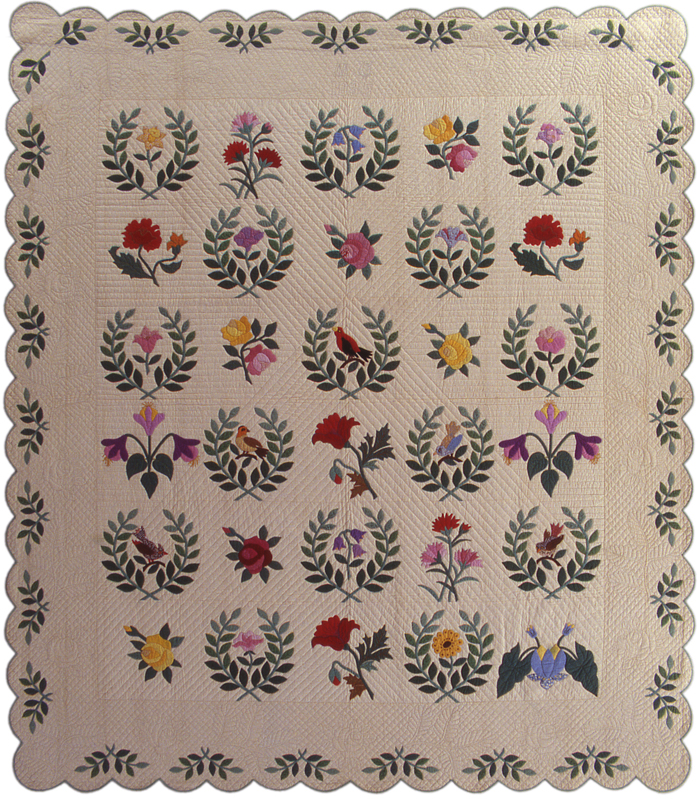
Laurel Leaf
Mary Gasperik
Chicago, Illinois
1935
Private Collection
This Gasperik quilt, bearing the year 1935 in its quilting, differs from the original Nancy Page Quilt Club series quilt designed by Florence LaGanke which inspired it. In 1934-1935, the Laurel Wreath series appeared in newspapers nationwide, including in Chicago and Detroit. Twelve of the 15 wreath blocks use Nancy Page flower and bird patterns. Gasperik elaborated on the Page bird patterns, incorporating a wider variety of fabrics and shapes than the commercial pattern specified. The 15 blocks which do not have the iconic Page wreath use floral patterns from outside sources. Three are from Nancy Cabot/Chicago Tribune. One is from the Priscilla Patchwork Book, and Gasperik adapted one from a quilting pattern from Home Art Studios. The remaining four bird and flower patterns are from as-yet-unidentified non-Page sources.
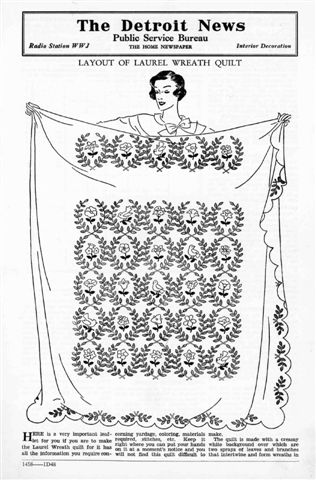
Original Laurel Wreath Pattern layout from The Detroit News
Floral appliqué and embroidery filled her quilt surfaces. These designs, often used in kit quilts in the 1930s and 40s, may have reminded her of the Hungarian embroidery she had been taught as a young girl. She was obviously attracted to them (she made quite a few), but she often added extra appliqué touches that the kits did not include, such as the appliqué birds that were not included in this kit Wild Flower Wreath (Paragon kit #01010).
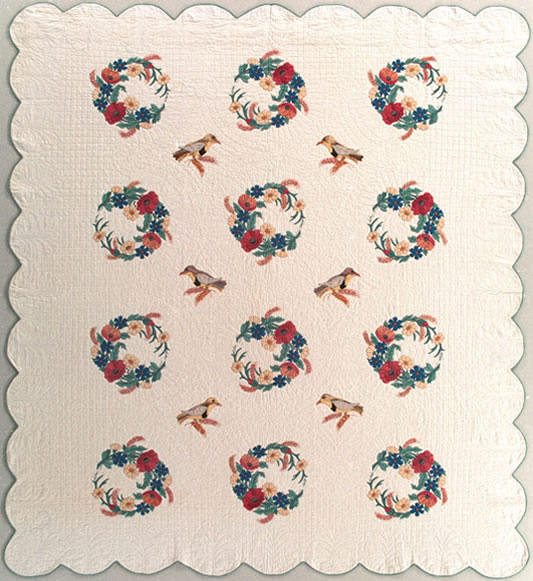
Wild Flower Wreath
Mary Gasperik
Chicago, Illinois
1937
Private Collection
This late 1930s quilt Paragon kit #01010 (Wild Flower Wreath) has been modified by Gasperik who added six meadowlarks from an outside source, plus the embroidered wheat, a Hungarian national emblem that appears on many of her quilts. Its scalloped border is also Gasperik's addition to the Paragon design. Gasperik added to and altered commercial patterns throughout her quilting career.
It was the custom among expert quiltmakers in the 1930s to duplicate antique quilts. Marie Webster's book Quilts: Their Story and How To Make Them was one of the earliest quilt history books that contained photographs of actual quilts. Gasperik owned a copy of the book. She made her own patterns for her Double Feather Star quilts and for Indian Feather Star using Webster's photos. In the case of Double Feather Star, only a portion of the quilt was visible in the black and white photo in the book. From this rudimentary design source, Gasperik re-created the quilt and made at least two other versions.
Indiana Wreath, of which she made four copies, was also based on an antique red-and-green appliqué quilt in Marie Webster's 1915 book, but Gasperik chose not to reproduce the round wreath of the antique quilt; instead she shaped an elongated oval wreath. However, even Gasperik's adaptation might have been inspired by a commercial pattern. McCall's Needlework (Winter 1937-38) featured the Indiana Wreath (Pattern #524) with a slightly oval shaped wreath inside a rectangular quilt.
The original antique quilt was square. Other quilt designers and book authors in the 1930s created patterns for that same antique quilt. These included Carrie Hall and Rose Kretsinger in Romance of the Patchwork Quilt (1935) and Mary McElwain in Romance of the Village Quilt (1936). Gasperik may have borrowed from a number of them. Notice she added hovering blue birds, which did not appear in any of the sourced designs mentioned above.
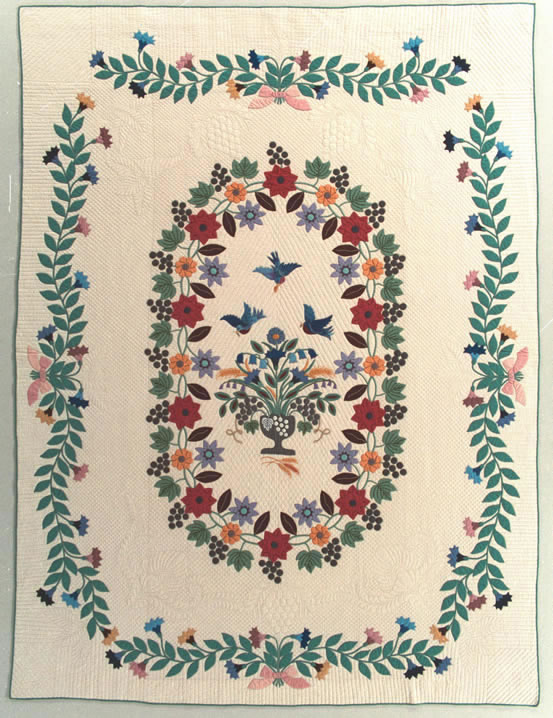
Indiana Wreath
Mary Gasperik
Chicago, Illinois
1938-1945
Private Collection
Mary Gasperik made at least 4 Indiana Wreath quilts. It would seem that she picked this complicated and famous pattern precisely to demonstrate what a master quilter she was.
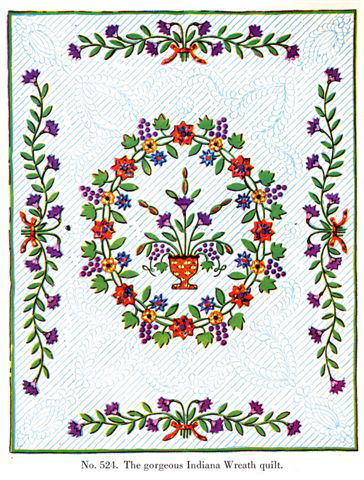
Original 1937-38 McCall's pattern illustration for Indiana Wreath.
Quilts Made for Family
Quilts made for her grandchildren in the 1940s often began with commercial quilt kit packages that included stamped cloth for appliqué, embroidered stitching lines as well as quilting lines. Kits for children's quilts were popular and inexpensive. Most cost about $1.95 in the late 1930s and early 1940s. Gasperik used Paragon kit #01013 "Farm Design" to make twin bed quilts for granddaughters, Karen and Linda Krueger. She appliquéd their names on the quilts and added the boy on horseback which was not part of the original kit design to represent their father University of Chicago economics instructor, Maynard C. Krueger, as a Missouri farm boy.
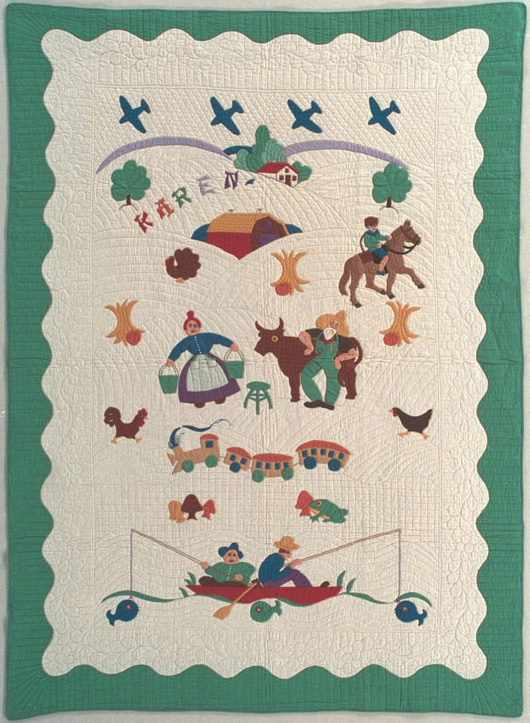
Farm Design
Mary Gasperik
Chicago, Illinois
1941
Private Collection
This quilt is one of a pair of youth-sized quilts made for Gasperik’s grand-daughters Karen and Linda using Paragon #01013 "Farm Design" (also see quilt ). To each, she added the child’s name and a boy on a horse to represent their father University of Chicago economics instructor, Maynard C. Krueger, as a Missouri farm boy. The Japanese-style letters and the little boy astride the horse are from outside sources. In 2003 Gasperik granddaughter Joanne Gasperik, a prize-winning quilter in her own right, copied Karen's quilt to make a gift for the third Krueger sister, Susan. It is not known if Mary Gasperik won any ribbons for the two Farmer in the Dell quilts she made for Karen and Linda; but her granddaughter Joanne won one for the quilt she made for her cousin Susan! That quilt was a semi-finalist in the 19th annual American Quilter's Society Quilt Show & Contest in Paducah, Kentucky in 2003.
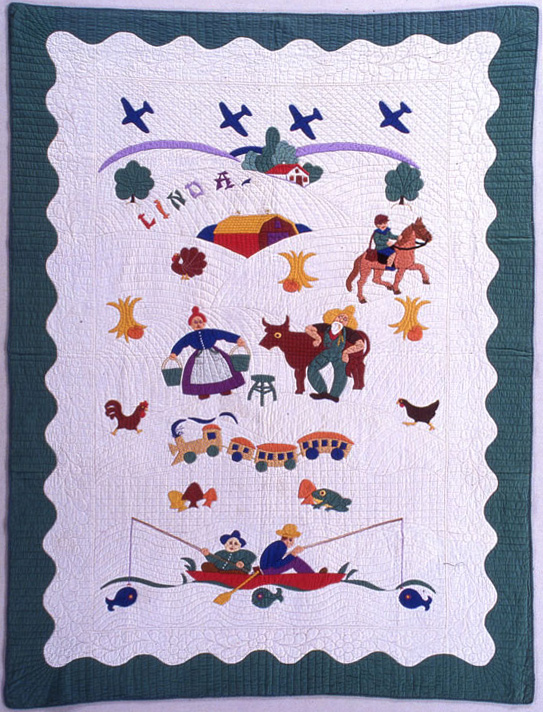
Linda's Farm Design
Mary Gasperik
Chicago, Illinois
1941
Private Collection
For her own adult children, she also made quilts to celebrate weddings and anniversaries. Bridal Bouquet made for son Elmer and his wife Doris's 1944 anniversary contains Mary's favorite lily bouquet and white bowknot appliqués.

Bridal Bouquet
Mary Gasperik
Chicago, Illinois
1944
Private Collection
In this 1944 wedding quilt Gasperik tapped multiple sources to create an original design. She transposed a Detroit News Lily quilt pattern into an appliqué lily at the bouquet's center. Other appliquéd floral designs in the bouquet may have come from Nancy Cabot/Chicago Tribune. The appliquéd flower girl is likely Gasperik's assemblage of ideas from multiple sources. For example, Gasperik might have taken her idea to embroider sausage curls under the girl's bonnet from a W.L.M. Clark (Grandmother Clark) set of quilt block patterns called Poster Girls advertised in Herrschner catalogs 1935-1937. The ferns and feathers quilted in abundance on this and other quilts came from an Aunt Martha quilting booklet.
Quilt projects made for specific family occasions and for specific children make assigning dates to the quilts much easier, and they also aid quilt historians who value such information to confirm the date of manufacture of particular quilt kits.
Her Masterpiece Quilts
At the outset of this research project, I thought these three quilts were Mary Gasperik's own designs: Road to Recovery, Colonial Quilting Bee, and Hungarian Harvest Festival. In fact, it is now obvious that she made these quilts the way she made her others by starting from a design source that was not her own. It was interesting to discover those sources—Road to Recovery with its winding road to the New York World's Fair was based on a kit design with a similar winding path. The layout of Colonial Quilting Bee is an exact duplicate of a quilt designed for The Detroit News by another "club" member – Marjorie Miller. Hungarian Harvest Festival has as its border design the scalloped and concentric borders of Bucilla kit #2004 "Morning Glory."
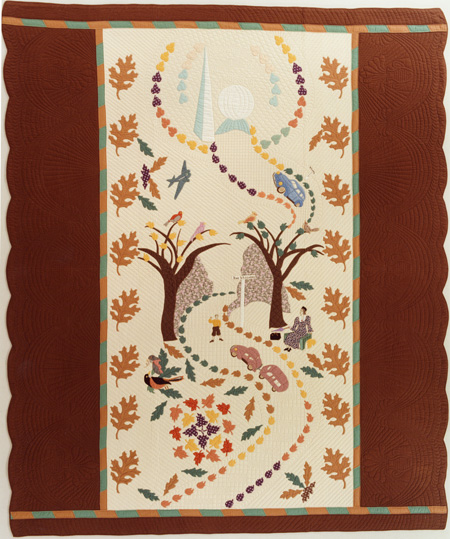
Road to Recovery
Mary Gasperik
Chicago, Illinois
1939
Private Collection
Mary Gasperik's original design to commemorate the 1939 New York World's Fair was made for a quilt contest "Better Living in the World of Tomorrow." She did not win a prize, but it is considered one of her masterpiece quilts. Although she did not sign this quilt, she often said the seated woman appliquéd in the center of the quilt represents herself. The pattern source for two of the appliqué elements in this quilt, the pair of robins in the lower left and the brown wren at the right side of the tree on the right, have been identified. Gasperik traced them from illustrations by Fern Bisel Peat published in popular books about birds printed in the early 1930s. In copying the robins from a book, Gasperik not only traced the book illustration's outlines to create her appliqué pattern, but she also duplicated Peat's detail through elaborate embroidery.
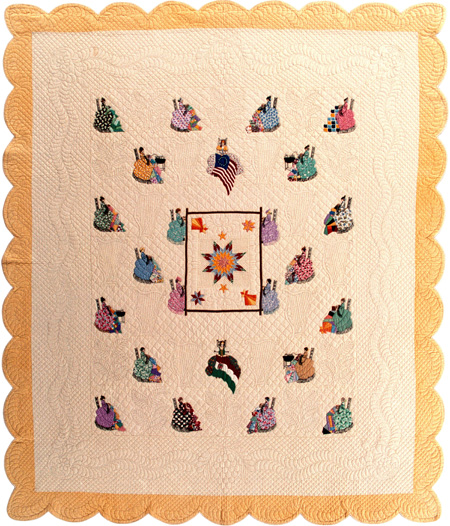
Colonial Quilting Bee
Mary Gasperik
Chicago, Illinois
1935-1940
Private Collection
Considered one of her masterpiece quilts, Colonial Quilting Bee is a prime example of Gasperik's fine embroidery and quilting skills. However, it is not an original design. Two of the appliqué designs for the seated quilters originated with the Detroit News Quilt Club, organized by Edith Crumb. Arranging the quilters around a central quilt frame was not Gasperik's idea either. Mrs. Arthur Miller of Detroit had made a similar quilt and Mary probably saw it on display in 1935, the first Detroit quilt show Mary attended. A November 7, 1936 Detroit News quilt column indicates "Mrs. Arthur Miller has had a letter from Mrs. Mary Gasperick [sic], one of our Chicago members..." The Miller quilt reappeared at the May, 1940 Detroit Quilt show, where it won third prize to Gasperik's second prize award (for the quilt called Hungarian Harvest Festival). It is quite likely that Gasperik got patterns for making Colonial Quilting Bee from Miller.
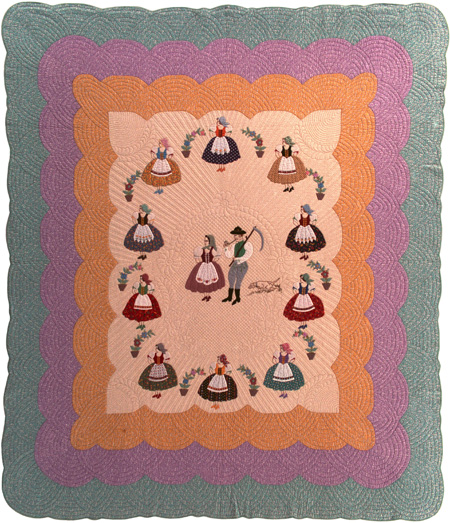
Hungarian Harvest Festival
Mary Gasperik
Chicago, Illinois
1940
Private Collection
This quilt, finished in time for the May 1940 Detroit News Quilt Show, is a family favorite. Gasperik began work on this project immediately after she returned home from the 5th Detroit News Quilt Show, held Oct. 7-9, 1938. The October 22, 1938 Detroit News quilt column written by quilt club editor Edith B. Crumb featured a picture of a Hungarian peasant girl appliqué sample block which Gasperik sent to Detroit for Crumb to share with fellow members of the Friday afternoon Quilt Club Corner, who gathered weekly in the basement of the WWJ radio station. At the 5th Detroit News Quilt Show Gasperik had won the $25 top prize for appliqué (News pattern) and she was no doubt eager to start a quilt entry for the next Detroit show, one which might win her the highest prize ($50) they offered, the Grand Prize.
Nevertheless, Gasperik has improved upon others' designs. Her needlework expertise raises her work above the standards of quilts being made in the 1930s and 40s. More importantly, these three quilts taken together reflect her immigrant's voyage from stranger to citizen. Her Colonial Quilting Bee, in particular, represents her quilt journey. At the center of Gasperik's quilt is a miniature quilt with a Star Arcturus - Century of Progress block, and one of the quiltmakers working on a Star Arcturus quilt (seen at right) is thought to be a self-portrait. The source of all this good fortune came from her visit to Chicago's 1933 Century of Progress Exposition where she saw some quilts that changed her life. In seeking a way to make similarly beautiful and expressive quilts, she found a group of supportive and enthusiastic quiltmakers eager to make her one of their own.
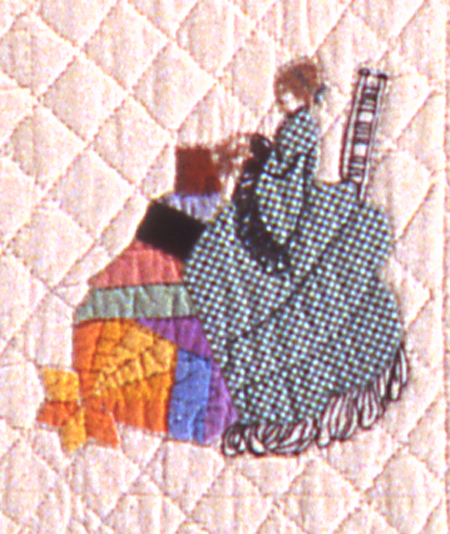
The self portrait block of the Colonial Quilt Bee quilt.
Merikay Waldvogel, September 2008
With Research Assistance from Susan Krueger Salser
All rights reserved
-
Legacy
Gasperik Legacy Project, Mary -
Essay
American Quilts Empowered Immigrant Wo...
Salser, Susan
-
Essay
Mary Gasperik and the Tuley Park Quilt...
Waldvogel, Merikay
-
Essay
Mary Gasperik and the Detroit...
Salser, Susan
-
Gallery
Gasperik 01: Masterpiece Quilts
Waldvogel, Merikay
-
Gallery
Gasperik 02: Antique Quilt Design Sour...
Waldvogel, Merikay
-
Gallery
Gasperik 03: 1930s Quilt Pattern Sourc...
Waldvogel, Merikay
-
Gallery
Gasperik 04: Kit Quilts
Waldvogel, Merikay
-
Gallery
Gasperik 05: Gifts for Children
Waldvogel, Merikay
-
Gallery
Gasperik 06: Gifts for Weddings & ...
Waldvogel, Merikay
-
Gallery
Gasperik 07: Appliquéd Blo...
Waldvogel, Merikay
-
Gallery
Gasperik 08: Mystery Quilts - Unidenti...
Waldvogel, Merikay
-
Gallery
Gasperik 09: Wholecloth Quilts
Waldvogel, Merikay
-
Gallery
Gasperik 10: Practical Quilts
Waldvogel, Merikay
-
Story
Mary Gasperik's Road to Recove...
Salser, Susan
-
Collection
1933 Sears National Quilt Contest Disc...
Waldvogel, Merikay
-
Collection
Detroit News Quilt History Project
Salser, Susan
-
Gallery
Understanding Quilt-Specific Colors: N...
Sikarskie, Amanda Grace
-
1933-1934
Tulip Basket Gasperik, Mary
-
1938-1940
Hungarian Harvest... Gasperik, Mary
-
1938-1945
Indiana Wreath Gasperik, Mary
-
1938-1945
Indiana Wreath Gasperik, Mary
-
1938-1945
Indiana Wreath Gasperik, Mary
-
1934
Star Arcturus-Cen... Gasperik, Mary
-
1935-1940
Colonial Quilting... Gasperik, Mary
-
1935
Colonial Sewing B... Miller, Marjorie
-
1937 circa
Double Feather St... Gasperik, Mary
-
1935
Laurel Wreath Gasperik, Mary
-
1937-1949
Meadow Lark and P... Gasperik, Mary
-
1941
Farm Design Gasperik, Mary
-
1944
Bridal Bouquet Gasperik, Mary
-
1939
Road to Recovery Gasperik, Mary
Load More
